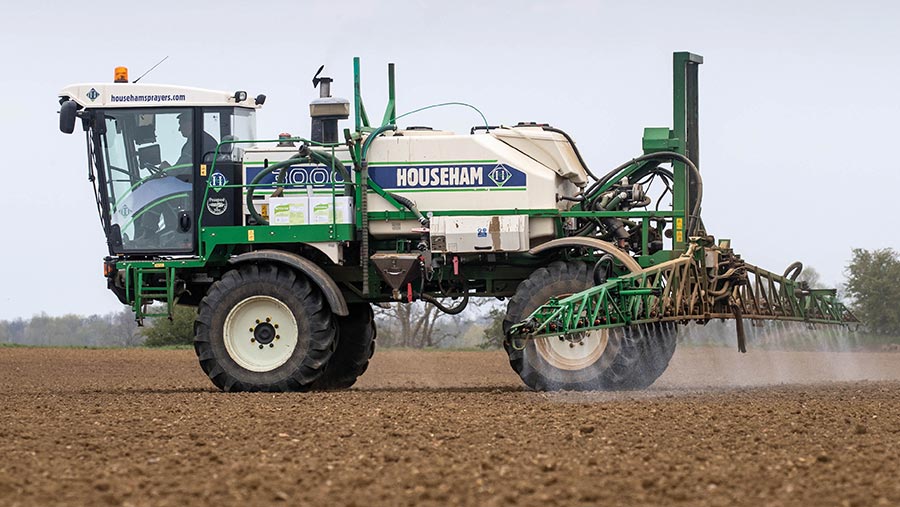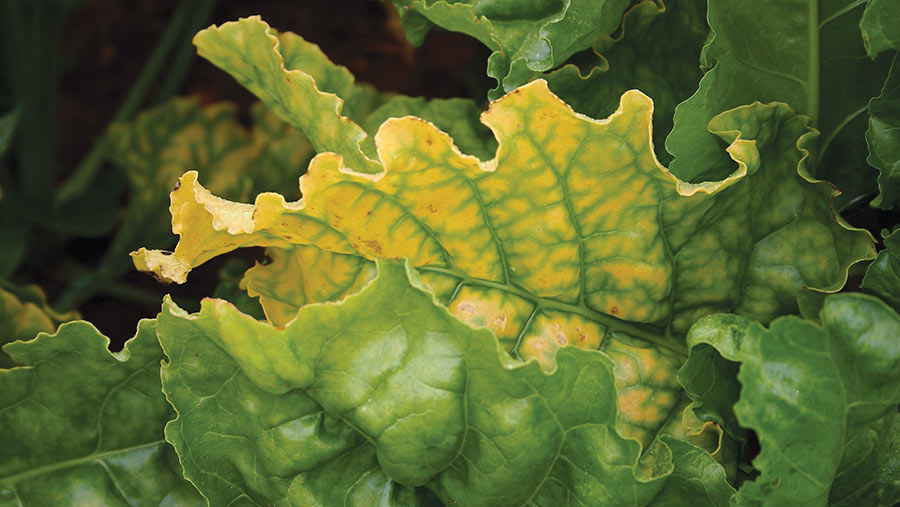Aphid pressure mounts in sugar beet crops – what you can do
 © Tim Scrivener
© Tim Scrivener Aphids are now flying and sugar beet growers are being urged to check their crops, as some have already reached the spray threshold for these vectors of virus yellows in what is being forecast to be a challenging season.
Virus yellows is capable of reducing yields by up to 50% and current forecasts are that it could be similar to 2020, a season remembered for the disease.
See also: Buyer’s guide: Camera-guided sugar beet hoes
Mark Stevens, head of science at the British Beet Research Organisation (BBRO), points out that some crops have already reached threshold for aphids.
The disease is spread mainly by the peach-potato aphid.
“Even though aphids are flying two to three weeks later than 2020, it’s worrying as many crops are just emerging and are at the vulnerable phase with aphids now coming in.”
This is the critical time, as once they get to the 12-leaf stage, mature plant resistance kicks in. So what should farmers be doing?
One key factor this season is that the Health and Safety Executive granted a derogation for the use of Cruiser SB (thiamethoxam) seed treatment, triggered by the Rothamsted predictions of 69% incidence if no action is taken.
Untreated crops
The priority at the moment is for non-Cruiser crops, which accounts for about 25% of the area.
Growers are being urged to start regularly checking them for aphids, as they are starting to be seen in these non-seed treatment treated crops.
If they reach the threshold of one green wingless aphid per four plants up until the 12-leaf stage, then treating with a foliar spray is justified.
After the 12-leaf stage, the treatment threshold is one green wingless aphid per plant and after the 16-leaf stage, there is no need to spray.
The good news this year is that there are two fully approved actives for use, there was only one last year.
Growers can make up to one application of flonicamid (either Teppeki or Afinto) plus one application of newly approved InSyst (acetamiprid).
BBRO is hoping to get emergency approval of a third product (spirotetramat), to give growers up to three sprays.
Cruiser-treated crops
Prof Stevens says the neonicotinoid seed treatment would normally offer up to 12 weeks’ protection, but the emergency approval was for a lower rate (45g versus 60g/100,000 seeds) and work suggests it will be nearer 10 weeks.
“So when you get to week eight, start checking crops and if aphids do reach the threshold, growers can spray flonicamid.”
If they reach the threshold again, then growers can use acetamiprid in the second spray.
“This sequence is a requirement for the emergency approval of the neonic seed treatment,” says Prof Stevens.
However, for non-Cruiser crops, growers can use the two in any order. Details of any further approvals will be highlighted by BBRO in future publications.
BBRO bulletins
Growers are advised to sign up for the BBRO bulletins, as the organisation will be monitoring aphid numbers and virus pressure throughout the season.
“These can act as an early warning,” says Mark Stevens.
The BBRO aphid-monitoring network is now active and covers up to 50 sites, which are split into Cruiser and non-Cruiser sites.
For those looking for real-time data, these are available on BBROplus, register for this service here
Breeding solution

Virus yellows infected beet © Blackthorn Arable
Breeding is seen as the long-term solution for virus yellows and BBRO trials are making some good progress, with some showing no significant yield loss.
Alistair Wright, BBRO crop protection scientist, explains that the key challenge is that the disease is caused by three viruses, not one single one, with similar symptoms and varying degrees of yield loss (see below).
- Beet chlorosis virus (BMYV) – up to 25% yield loss
- Beet mild yellowing virus (BYV) – more damaging with losses up to 30%
- Beet yellows virus – most severe at up to 50% losses
Two are related, while the third (beet yellows) is from a different family.
BBRO has been carrying out three different strands of work as part of Project Emerald: creating ratings for varieties on the 2023 Recommended List; testing tolerant varieties of beet; and testing if tolerance varies with timing of infection.
In the second strand, BBRO invited breeders to come forward with contenders, which were tested in inoculation trials.
“We have seen some good results, with some contenders showing no significant yield losses when exposed to beet mild yellowing virus.
“However, we have seen no varieties that can hold their yield for beet yellows virus, say Dr Wright.
In the third strand, work confirmed the value of plant age on tolerance. As the crops become more mature when they become infected, they lose less yield.
Project Emerald is ongoing until 2024.

